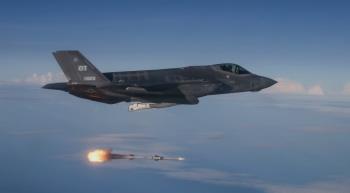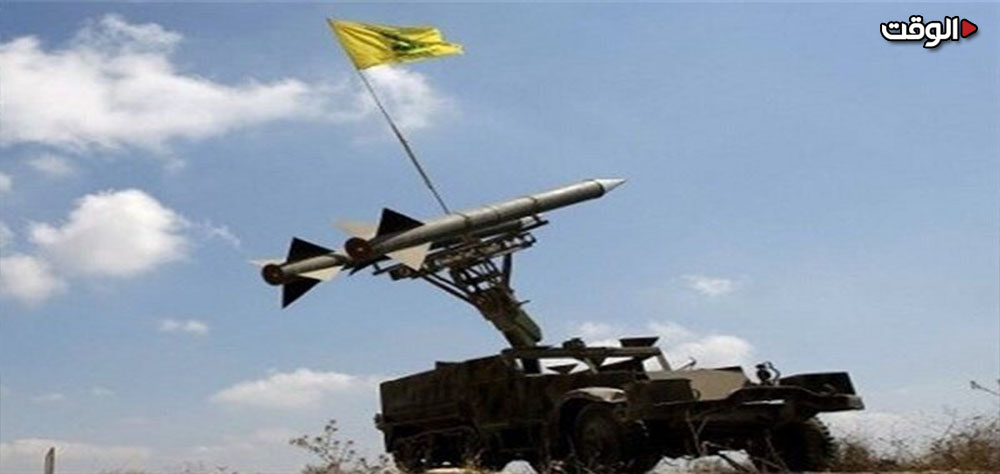Alwaght- Eight months after start of Gaza war and along with unfolding ground operation of the Israeli military in Rafah city, the battle on the northern front is growing heated day by day, with Lebanese Hezbollah unveiling new military capabilities in support of the Palestinians people.
In the newest development, on Thursday, the resistance movement stated that it for the first time used air-to-ground missiles in its attacks on the occupied territories.
A Hezbollah statement said that "for support of the firm nation of Palestine in Gaza Strip and its glorious resistance, the Islamic resistance struck Al-Mutala military base and the facilities inside it with two S5 missiles fired from a combat drone."
Hezbollah added that the drone fired its two missiles at a military vehicle and the crew inside it and killed or wounded them upon arriving the operation area. This drone struck its target with accuracy after firing its missiles.
This was the first time that Hezbollah announced the use of this type of weapon since the start of clashes with the Israeli regime. After this operation, Israeli media admitted that Hezbollah used drones equipped with S5 air-to-ground missiles for the first time in the attack on Al-Mutla base.
Hezbollah has a large-size arsenal of weapons that has expanded significantly in recent years. The movement has repeatedly said that it has advanced weapons, including pinpoint-accuracy missiles that can attack deep into Israel, and the unveiling of the S5 was a small part of its defense power.
S5 capabilities
S5 is a non-guided 55-mm missile that is fired from fighters and helicopters to attack targets. The missile works with solid fuel and its warhead is highly explosive.
The S5 missile operates through a mechanical valve and was first used by Russian forces in World War II.
This missile consists of three parts: Strong explosive warhead, solid fuel engine, folding tail fins.
It is launched through a 57-mm tube, where fins are placed at the end of the missile to create a stable spin when launched from a designated location.
"The S5 missile is a much smaller version of the American Hellfire air-to-ground missile that the Lebanese army used against ISIS in 2017. Hezbollah's use of this type of missile is unusual, not only because the drone was carrying two missiles, but also because it was a kamikaze drone with a warhead on it, something no military in the world has ever done, but Hezbollah has achieved this ability," Elijah J. Magnier, a Brussels-based veteran war correspondent and a senior political risk analyst, told L'Orient Today.
Hezbollah and strategy of eye-for-eye in war
Since the beginning of war, Hezbollah leaders have warned that along with expansion of the Israeli operations in Gaza, they will increase their anti-Israeli operations phase by phase. So, after unveiling the guided missiles and the 500-kg Burkan missile, this time S5 was a surprise of Hezbollah carrying a clear message to the Israeli enemy that the resistance movement has powerful weapons and Tel Aviv should not ignore the red lines.
Unveiling S5 came in response to the Israeli invasion of Rafah. So, Hezbollah's escalation using powerful weapons is meant to force-stop the Israeli war in Gaza and carries the message that if the enemy continues its genocide in Rafah, new arms will be used in the future.
The ramp-up of Hezbollah 's attacks has created panic among the Israelis, and estimates in Tel Aviv indicate that Hezbollah is prepared for war and any kind of scenario. With the unveiling of S5, the Israeli media admitted that Tel Aviv has lost deterrence on the northern front with Lebanon and that the story of October 7 is now being repeated in the northern regions, but Tel Aviv authorities are not aware of its dangers.
Deterrence boost; an alarm to new Netanyahu adventure
Hezbollah's unveiling of the new missile in the present conditions seeks another goal: Boosting deterrence power against the Israeli regime.
The media reports and remarks by Israeli officials in recent weeks showed that this regime intends to show a sharp reaction to Hezbollah's attacks on the northern front in the last eight months after finishing the Gaza war and start a military adventure in Lebanon. Currently, Hezbollah's military operations have caused the displacement of hundreds of thousands of Israeli settlers from settlements near the border with Lebanon, and this issue itself has stirred a crisis and doubled the burden on Netanyahu's war cabinet. Despite the promises of the government and the army to ensure the security of the settlements, the settlers are not willing to return to their homes, and therefore it seems that the army is preparing to rebuild the security belt on the northern front.
Due to their involvement in Rafah, the Israeli PM and his cabal are incapable of responding to Hezbollah and engaging in multiple fronts, but pieces of evidence show that in the future, new waves of attacks on Lebanon will be on the agenda of Netanyahu.
Israeli Defense Minister Minister Yoav Gallant on Friday and during a visit to areas in the north of occupied Palestine, acknowledged the heavy damages caused by attacks, saying: "We are ready for all options and we must continuously target the source of missile and drone attacks."
Tel Aviv officials' admission of losses shows that the amount of destruction caused by Hezbollah's frequent and daily attacks is extensive, and according to some Hebrew-language media, the settlements close to Lebanon are now ghost towns and have become uninhabitable.
This large scale of damages comes while Hezbollah has so far used only a part of its weapons capabilities, and the movement's leaders earlier had warned Tel Aviv that they have not yet unveiled many of their weapons, and in case of a full-scale war, they will unleash their powerful arsenal against the occupation.
Until recently, Hezbollah drones had to commit suicide in order to strike Israeli positions, but with the advent of the S5 missile, the rules of the war have changed, and with flying at a low altitude and escaping from interception systems, the resistance forces can fire this missile at enemy targets.
Hezbollah drones have recently managed to score some success filming from the occupied territories and gathering intelligence from the enemy positions and bases. However, Hezbollah's new surprise showed that in this area, too, it has relatively increased its deterrence and can match the enemy militarily.
The Israeli army has already revealed all of its military capabilities in Gaza war and nothing has remained hidden to Hezbollah. But things about Hezbollah are different for Tel Aviv and the Netanyahu government had no accurate information about number of Hezbollah missiles and size of its powerful arsenal. Therefore, contrary to Israeli government's claim that it will return Lebanon to the stone age in case of war, it cannot again wrestle with Hezbollah.
Former Israeli officials have admitted and warned that should a war with Lebanon break out, Hezbollah will fire 2,000 missiles at Israeli regime daily.
Taking revenge for assassinations in southern Lebanon
Another driver for use of new missiles in Hezbollah strikes is the attacks launched by Israeli fighter jets and drones in southern Lebanon in recent months that have targeted a number of Hezbollah members and Lebanese civilians.
By changing the rules of engagement and use of new missiles, Hezbollah tries to take revenge of the Lebanese martyrs and deter the enemy from further such crimes in the future. So, firing S5 was a warning shot to Tel Aviv that Hezbollah's strategic patience has ended and the movement has prepared a reciprocal scenario should these Israeli attacks continue, and from now on, ordinary movement of any kind in the northern cities can be a legitimate target for resistance forces.



























